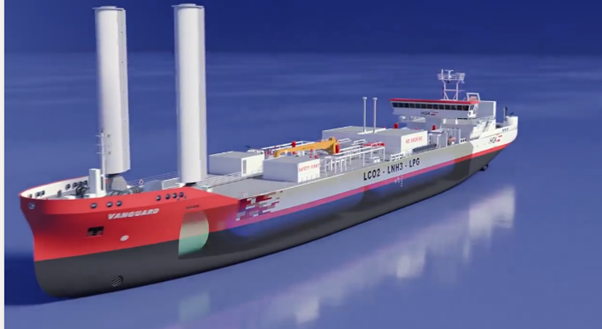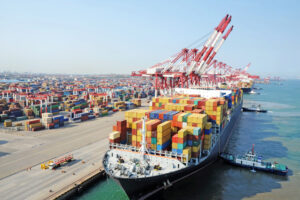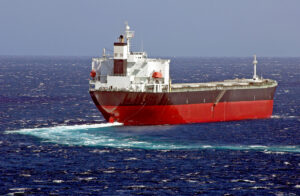
Clarksons calls for immediate action on LCO₂ shipping after the European Commission’s decision to pass on CO₂ storage obligations to 44 oil and gas producers across the European Union. The bloc must facilitate at least 50 million tonnes of annual CO₂ injection capacity into geological storage sites by 2030 and the companies must submit a detailed plan on how they intend to meet their obligations by 30th June 2025.
London-based Clarksons, a company providing shipbroking, research, finance, digital tools, port services and green-driven advisory services, says “shipping will be the only realistic transportation option to connect emission sources with storage sinks.”
LCO₂ shipping is still an emerging market, with few vessels currently in operation or under construction, most of which are already committed for the next 10 to 15 years. In accordance with Clarksons, this makes the construction of new vessels essential.
“It offers shorter lead times than pipelines, greater flexibility and scalability, simpler permitting processes, and in many cases, better economic efficiency” says Kenneth Tveter, Global Head of Green Transition and LCO2 at Clarksons.
While many shipowners are eager to enter the LCO₂ space, few are willing to order vessels without long-term contracts in place.
LCO2 carrier newbuild projects can be a complicated process and the vessel needs to be suitable for the value chain strategy. Initiating this process immediately is crucial, Clarksons notes, as vessel construction alone takes 2-3 years. This is in addition to time-consuming phases such as FEED, vessel design, and various negotiations.
“The shipbuilding market is complex and the yards appetite and capability to build LCO2 carriers is dynamic and market dependent. Executing newbuilds requires unique yard competence and commercial and technical knowledge. If you are not working on your LCO2 shipping strategy today, including project execution plans, you’re already behind,” noted Vebjørn Kjerstad, LCO2 Shipping specialist at Clarksons.
Projects that delay these steps will fall to the back of the queue, and shipyard capacity is limited. In other words, any project aiming to store or dispose of CO₂ by 2030 – and not located next to a suitable storage site – must begin developing its LCO₂ shipping strategy “today.”
Recently, the Japanese shipping company Mitsui O.S.K. Lines (MOL), subsidiary of energy company Petroliam Nasional Berhad (PETRONAS) in Malaysia, PETRONAS CCS Ventures, and maritime conglomerate MISC BERHAD (MISC), have launched the joint venture Jules Nautica Sdn. Bhd. to lead the development and act as the ultimate owner of liquefied carbon dioxide (LCO2) carriers, which are critical for transporting LCO2 to designated storage sites.
The joint venture’s aim is to become a leading owner of LCO2 carriers, facilitating the transportation of LCO2 to designated CO2 storage sites.
The joint venture is focused on supporting the future carbon capture and storage (CCS) projects across the Asia Pacific region, according to the MOL and MISC release.
The three parties have recently completed the front-end engineering design for a 62,000 cubic meter LCO2 carrier, which was awarded to Shanghai Merchant Ship Design and Research Institute (SDARI).
As reported by Shipping Telegraph on December 3, the Japanese shipowner Nippon Yusen Kabushiki Kaisha (NYK) and its affiliate Knutsen NYK Carbon Carriers AS (KNCC) based in Norway are to conduct a joint constructability study of a 40,000-cbm terminal-to-terminal liquefied CO2 vessel.
The partners said the vessel will be based on KNCC’s technology of LCO2-Elevated Pressure Cargo Tanks together with Nihon Shipyard Co., Ltd., a joint venture for ship design and sales between Imabari Shipbuilding and Japan Marine United Corporation.
KNCC will provide the technical and regulatory expertise on the LCO2-EP vessel, whilst NYK will develop the overall policy and evaluate the constructability and appropriateness.
Meanwhile, seven of Japan’s leading companies in shipping and shipbuilding have won an approval from class society ABS for two liquid carbon dioxide (LCO2) carrier designs.
The American Bureau of Shipping (ABS) has awarded approval in principle (AiP) to two liquid carbon dioxide (LCO2) carrier designs with type-C cargo tanks that do not require performing post-weld-heat-treatment based on the demonstration of an engineering critical assessment.
The giant Japanese companies Mitsubishi Shipbuilding Co., Ltd., Nihon Shipyard Co., Ltd., Kawasaki Kisen Kaisha, Ltd., Mitsui O.S.K. Lines, Ltd., Nippon Yusen Kabushiki Kaisha, Mitsui & Co., Ltd., and Mitsubishi Corporation worked together for the LCO2 carrier designs.
ABS reviewed the drawings based on class and statutory requirements for the two designs.
The two designs – a 50K cubic meter carrier and a 23K cubic meter carrier – are featuring type-C cylindrical tanks made of carbon manganese steel that stows the liquefied CO2 with low-temperature and low-pressure.
Furthermore, Germany’s inland waterway shipping company HGK Shipping has designed the first river-seagoing gas tanker in Europe to transport cold liquefied ammonia (NH3) and liquefied CO2 (LCO2).
Using the “Vanguard” project name, the river-seagoing gas tanker is 125 metres long and 17.50 metres wide is able to transport cold liquefied ammonia and liquefied carbon dioxide in its tanks.
The modern ship will not just travel along rivers, but it can also operate in European coastal waters and beyond.


